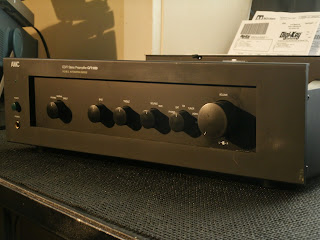Sansui AU-717 Integrated Amplifier
So here we've got a incredibly clean and pristine AU-717 integrated amp. Theres quite a few thing I like about the AU-717. The layout is very clean, they used proper shielding over all AF sections that we like to see, the shielding itself is attractive ,matching the clean black gloss finish elsewhere. The PCB locations and mounting make for some fairly quick work, especially when pulling the driver sections. I should note to properly pull the protection/PS one needs to pull the dual power transformers. Also note, check your hex locations on the knobs first, on the 717 it really is a bitch.
Power Supply/Protection F-2663 PCB
Per my usual treatment I went with high temp, long life Panasonic FR/FCs strictly for this stage along with a pair of Nichicon high temp Bi-Polars (note some SM state 100/should be 220uf). The FR/FC series delivers exactly what you want in a power supply, reliability. Another addition is the installation of a new Omron relay, went with the 4PDT MY-4 variant with the low noise action.
Now as with most Sansui of this age and period we have some serious glue issues to attend to, the glue used is notoriously bad, it oxidizes to a degree and foreign particles create new tracing, as the glue sits on the component leads its causes oxidation and eats away at many resistors. I recommend replacing any component that came into major contact with it and deep cleaning the PCB. Another issue to note with the Sansui's are the fuse-able resistors. These absolutely need to go, when they fail they really fail and short. I recommend flame-proof MOX here.
BEFORE
AFTER
Along with the glue, you will encounter several coated diodes as well, the 1S2473 had a great modern drop in available the 1N4148 and the larger diodes consists of ultra fast UF4003/02.
Driver Stages F-2721/2722
For the lyrics on the driver stages I used audio grade Nichicon KW and Elna Silmic II capacitors. Again this board has the notorious glue on it, make sure ALL of it is remove and address and questionable resistors that were coated. This particular model did not, but some may have fuse-ables at R23/25/26/16 locations, again I recommend flameproof MOX.
The Au717 uses an interesting 1st stage topography along with a field-effect transistor FET (2SK97) differential package, and quasi complimentary pairs at TR01/02 & Tr03/04. It is recommend to update the TR01/02 and Tr03/04 as was performed in this unit with ZTX694B and 992's BJT's. On a last note I like to replace biasing/offset potentiometers, IF, their not the old big fat white ones (those are great) the Au717 uses a series of two pots (100/2.2K) to dial in the Offset and one 1K for the Bias, right angle bourns were used here along with the fore-thought too add test points, too bad we dont see insight like that often.
Pre-Tone Control PCB F-2720
One thing I really liked about working on the AU717, especially in this stage is the molex type connections. It took just a few minutes to pull this section along with the huge enclosed stepped attenuator and F2666/F2665 assemblies for cleaning. All the lyrics here were replaced again with audio grade Elna Silmic II's. One important thing to note is the AU717 used quite a few VD1212 type varistor diodes. These should all be removed and replaced with something a little more reliable and new, two 1N4148 in series (cathode to anode) work excellent. Also, note we have 4X 82.5 ohm fuse-ables that need to be replaced with MOX or equivalents. This is a great time as I mentioned to pull the F2666/2665 assemblies to clean the controls, and tap the large enclosed attenuator to clean and lubricate.
F2666/2665
EQ PCB F-2723
The EQ is fairly straightforward to work on, one can pull the extended shaft controls and simply pull the molex type connectors again ( :) ) All the lyrics were replaced with a low impedance , high reliability Nichicon PW and audio grade Elna Silmic II's here, the original C1/2 films were replaced with a better polypropylene WIMA film capacitor of the same value (250V). Again we see the VD1212 in X4 four position on this board D01-04 that need to be updated along with X4 four 82.5 ohm fuse-ables to replace.
The rear panel F-2670 PCB has two lyrics I replaced with Nichicon PWs again, all the filter caps were replaced with X4 four 15Kuf 63Vdc Panasonic THA's, sadly these are nearing their run, it will be hard to find such a good filter cap replacement.
Im very impressed with the AU717, I do wish the stepped attenuator had a vent, but that can be made, and as with most Kenwoods or Sansui's utilizing dual power supplies you usually end up pulling the Pformers out of the way. Still what a damn nice looking integrated, its is incredibly clean sounding I thought with just a touch of some lower end warmth. Quite impressed.

































